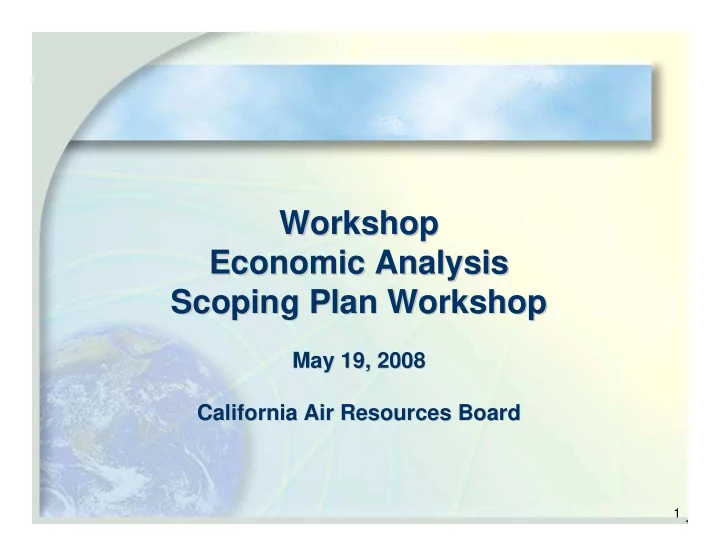

Workshop Workshop Economic Analysis Economic Analysis Scoping Plan Workshop Scoping Plan Workshop May 19, 2008 May 19, 2008 California Air Resources Board California Air Resources Board 1 1
Overview • Background • Energy 2020 Model: Base Case • Environmental Dynamic Revenue Assessment Model (EDRAM) • Berkeley Energy And Resources (BEAR) • What’s Next? 2 2 Internal Draft
Background • AB 32 Requires Economic Analysis • Role of Economic Analysis • Previous Meetings on Economic Modeling • Multi-Model Path for Analysis • Bottom-up and Top-down Types of Models • Current Status of Modeling 3 3 Internal Draft
Role of Economic Analysis •To Assess Potential Impacts of GHG Emission Reduction Policies •To Be Used as an Input into Board’s Decisions •Important Factors Models Can Help Address: � Jobs impacts � Income impacts � Costs � Business Impacts � Low-income Household Impacts � Emission Reductions 4 4 Internal Draft
Multi-Model Path for Analysis • Three economic models to support analysis • No single model will address all needs • Each model can provide useful information • Models can also work together to inform certain policy options 5 5 Internal Draft
Multi-Model Path for Analysis (Energy 2020 Model) • Multi-sector model of energy demand, supply, and prices • Policies disaggregated down to devices and processes • Evaluation of effects at end-use level • Results rolled up to sector level • Bottom-up Model 6 6 Internal Draft
Multi-Model Path for Analysis (E-DRAM and BEAR) • EDRAM and BEAR – Computed General Equilibrium – Policies aggregated to sector levels – Evaluation of effects at the sector level – A top-down Approach • Can Be Run Independently • Both Models Use Similar Data for Development • Sector Details Differ • BEAR Accounts for Technology Changes Over Time 7 7 Internal Draft
Multi-Model Path for Analysis • Model Integration – Energy 2020 investment, prices, and expenditures for – Input into EDRAM and BEAR – Results • Impacts on Jobs • Impacts on Income • Impacts on Output 8 8 Internal Draft
Current Status of Modeling • Energy 2020 Modeling – Business-As-Usual – Evaluation and basis for scenarios – Scenario development • Cap and trade • Carbon fee • All direct regulations • Effects of offsets 9 9 Internal Draft
Modeling • Intended to Evaluate Policies Relative to Each Other • Base Case Does not Need to Calibrate Exactly but Rather Approximate Accepted Projections • Sector Mapping of Energy 2020 to California Data • Transportation Characteristics • Emissions Projections Internal Draft 10 10
Today’s Workshop • Base Case Discussions • Top-down Scenario Modeling Methodologies – Core Measures, and – Cap and Trade – Carbon Fees – All Direct Regulations Internal Draft 11 11
Recommend
More recommend